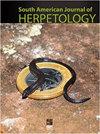Biological Effect of the Jelly Coat Diffusible Biomolecule of Rhinella arenarum in the Gametic Interaction during Fertilization
IF 0.7
4区 生物学
Q4 ZOOLOGY
引用次数: 0
Abstract
Abstract. In amphibians, the presence in the fertilization medium of diffusible components from the jelly coat, called diffusible factors, is indispensable. However, few studies of anuran species have characterized the biomolecule capable of inducing the acrosome reaction. Our previous studies of a species of anuran amphibian (Rhinella arenarum) from the Andean Yungas of northwestern Argentina demonstrated that uterine oocytes that contain the jelly coat lose fertilizability in the insemination medium depending on washing time and washing medium. Such loss can be reversed by the addition of all the proteins and glycoproteins from the diffusible factor (DF), an effect that reaches a maximum with the addition of exogenous Ca2+. In the present study, we employed an experimental model to demonstrate the biological effect of DF and of four purified protein fractions from DF on conditioning coelomic oocytes. Our experiments demonstrated that only purified fraction 2 of DF, which contains only a 74 KDa diffusible glycoprotein (gp74), caused characteristic modifications on the surface of the conditioned coelomic oocytes, identical to the ones generated by the acrosomal lysine solution. These modifications of the oocytes did not occur in the absence of sperm in the medium. Furthermore, previous treatment of a sperm suspension with gp74 and later incubation of the supernatant obtained from this pretreatment with the conditioned coelomic oocytes caused the same lytic effect on the oocyte surface, confirming that gp74 participates by inducing the release of the acrosomal content in the insemination medium. These results are a new contribution to the knowledge on the fertilization of this anuran species and allow us to continue with the study of the gp74 receptor in the spermatozoon.砂鼻草胶壳扩散生物分子在受精配子相互作用中的生物学效应
摘要在两栖动物中,在受精介质中存在来自果冻外壳的可扩散成分,称为扩散因子,是必不可少的。然而,很少有对无核物种的研究表明这种生物分子能够诱导顶体反应。我们之前对阿根廷西北部安第斯云加斯的一种无尾两栖动物(Rhinella arenarum)的研究表明,含有果冻外壳的子宫卵母细胞在受精培养基中会失去受精能力,这取决于洗涤时间和洗涤培养基。这种损失可以通过添加来自扩散因子(DF)的所有蛋白质和糖蛋白来逆转,这种作用在添加外源Ca2+时达到最大。在本研究中,我们采用了一个实验模型来证明DF和来自DF的四种纯化蛋白组分对调节体腔卵母细胞的生物学效应。我们的实验表明,只有纯化的DF组分2(仅含有74KDa可扩散糖蛋白(gp74))在条件体腔卵母细胞的表面引起了特征性修饰,与顶体赖氨酸溶液产生的修饰相同。在培养基中没有精子的情况下,卵母细胞不会发生这些修饰。此外,先前用gp74处理精子悬浮液,随后用条件体腔卵母细胞孵育从该预处理获得的上清液,在卵母细胞表面上引起相同的裂解作用,证实gp74通过诱导受精培养基中顶体内容物的释放而参与。这些结果为了解这种无核物种的受精情况做出了新的贡献,并使我们能够继续研究精子中的gp74受体。
本文章由计算机程序翻译,如有差异,请以英文原文为准。
求助全文
约1分钟内获得全文
求助全文
来源期刊
CiteScore
1.50
自引率
0.00%
发文量
10
期刊介绍:
The South American Journal of Herpetology (SAJH) is an international journal published by the Brazilian Society of Herpetology that aims to provide an effective medium of communication for the international herpetological community. SAJH publishes peer-reviewed original contributions on all subjects related to the biology of amphibians and reptiles, including descriptive, comparative, inferential, and experimental studies and taxa from anywhere in the world, as well as theoretical studies that explore principles and methods.

 求助内容:
求助内容: 应助结果提醒方式:
应助结果提醒方式:


